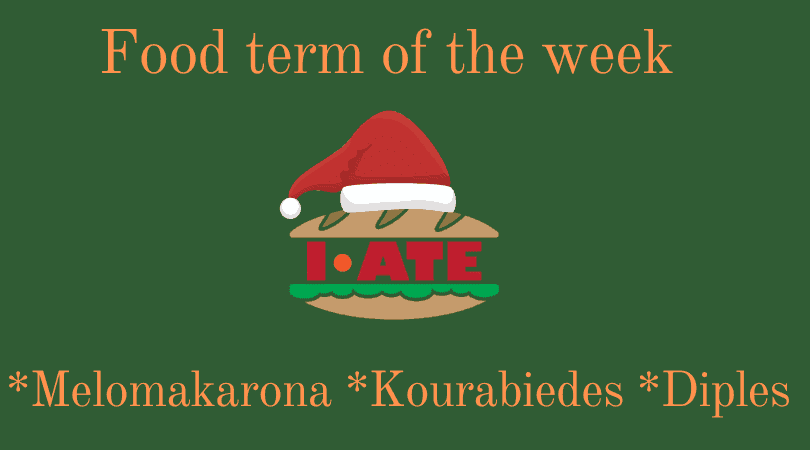This Christmas instead of the typical Christmas cookies and desserts, try to make some melomakarona, kourabiedes and diples! These three Greek sweet snacks are so tasty but unknown to the northern Europe. Therefore, if you want to impress your family, your friends and your colleagues this year, do prepare these festive snacks from Greece. Greek Christmas snacks
The kourabies is well known all over the Greece. It is a Christmas cookie made by fresh cow butter, flour, powder sugar and almond. It’s taste is sweet and buttery and the texture must be crunchy. It is shaped in different shapes. The Greek term κουραμπιές comes from the Turkish term kurabiye, which means cookie. The recipe:

Ingredients
- 700g fresh butter at room temperature
- 650g powdered sugar
- 1 vanilla capsule
- 30g brandy
- 1,200 g flour
- 2 tbsp baking powder
- 300 g white almonds, in very small pieces, unsalted
Preparation
Beat the butter with 150g of sugar at medium speed for about 5 – 7 minutes, until the mixture becomes white. Then, add the vanilla, almonds, brandy, 500 gr. from the flour and the baking powder. Continue to beat until the ingredients are mixed. Stop the mixer and continue kneading with your hands, gradually dropping the remaining flour until you have a smooth, firm dough. You stop adding flour when the dough stops gluing in your hands. Preheat the oven to 180 ° C. Transfer the dough to a smooth surface and open it with the rolling pin on a thick sheet. Cut the leaf into round pieces or crescent. We pick up the dough left in the ball, reopen it and cut it again.
The melomakarono is the most popular Christmas snack in Greece. It is made by flour, semolina, honey, olive oil and walnuts. This egg shaped cookie has very strong aroma of cinnamon, clove and orange. The Greek term μελομακάρονο comes from the Greek words μελι (honey) and μακαρία (a bread offered to peoples during funerals). The recipe:

Ingredients
For the syrop
- 500g water
- 800g sugar
- 150g honey
- 3 stick cinnamon
- 3 cloves
- 1 orange, cut in half
Mixture 1
- 400g Orange juice
- 400g seed oil
- 180g olive oil
- 50 g powder sugar
- 1/2 tsp cloves
- 2-3 tbsp. cinnamon
- 1/4 tsp nutmeg
- 1 tsp baking soda
- zest of 2 oranges
Mixture 2
- 1 kg flour
- 200g semolina
- For serving
- honey
- walnuts
Preparation
For the syrup: Boil the ingredients for the syrup, except honey. Note that you need to start the syrup 3-4 hours before start making the melomakarona. Preheat the oven to 190 ° C in the air. Then put all the ingredients of mixture 1 in a large bowl and mix with a good wire. In a second bowl, mix the ingredients of mixture 2. Add the mixture of the liquid ingredients to the mixture with the solids and mix gently with your hands for very short time. Roll the dough into a uniform egg shaped pieces (3-4 cm in diameter, 30 g each) and bake for about 20-25 minutes until melomacarona become crispy. Once they are ready, pour the hot melomakarono into the cold syrup and leave for 10-15 seconds. Then strain and sprinkle with honey and nuts.

The diples is a very delicate dessert and it symbolizes wealth and fertility. That’s why it is served as part of wedding and New Year’s celebrations in Greece. Diples are a typical dessert in the Peloponnese but it is also very popular in Cycladic and Dodecanese islands. Their name “diples” comes from the procedure they are shaped: by folding the dough.
Ingredients
- 500gr flour
- 5 eggs
- 1 pinch of salt
- 2 tbsp. olive oil
- 2 tbsp. sugar
- seed oil, enough for frying
For the syrup
- 800gr sugar
- 800gr water
- juice, from 1 lemon
- 2 cinnamon sticks
- 50gr honey
For serving
- honey
- cinnamon
- nuts, in tiny pieces
Preparation
Put the flour, eggs, salt, olive oil and sugar in a bowl and mix with a fork. Then knead well with your hands until the ingredients are homogenized and the dough is tight. Divide the dough into 5 balls and put them into the refrigerator for 2-12 hours.
When the dough is ready, roll each ball with the rolling pin on a floured work surface. It requires a lot of patience, but as we work with the rolling pin, our dough will soften and open very easily in the end. With the rolling pin open a large strip of 10-15 cm wide thin and then cut to a length of 20-25 cm. Put this piece as it is in a pan with plenty of hot oil and roll with 2 tablespoons as you fry.
Fry it in enough seed oil over medium-high heat until they turn a nice golden colour for about 2 minutes, making sure to put a few at a time so they don’t stick together. Remove them from the oil and put your diples on absorbent paper to drain and cool.
For the syrup: Add sugar, water, orange juice and cinnamon into a pan over medium-high heat. Boil for 5 minutes, then add the honey and remove from the heat. Simmer the diples in the hot syrup for 2 minutes each. Serve with honey, cinnamon and walnuts.
Sources:
Κουραμπιές, Wikipedia, https://el.wiktionary.org/wiki/%CE%BA%CE%BF%CF%85%CF%81%CE%B1%CE%BC%CF%80%CE%B9%CE%AD%CF%82, Accessed on 12 December 2019.
Μελομακάρονο, Wikipedia, https://el.wiktionary.org/wiki/%CE%BC%CE%B5%CE%BB%CE%BF%CE%BC%CE%B1%CE%BA%CE%AC%CF%81%CE%BF%CE%BD%CE%BF, Accessed on 12 December 2019.
Δίπλες, Wikipedia, https://el.wikipedia.org/wiki/%CE%94%CE%AF%CF%80%CE%BB%CE%B5%CF%82, Accessed on 12 December 2019.
Kourabiedes, Wikipedia, https://en.wikipedia.org/wiki/Kourabiedes, Accessed on 12 December 2019.
Melomakarono, Wikipedia, https://en.wikipedia.org/wiki/Melomakarono, Accessed on 12 December 2019.
Diples, Wikipedia, https://en.wikipedia.org/wiki/Diples, Accessed on 12 December 2019.
Qurabiya, Wikipedia, https://en.wikipedia.org/wiki/Qurabiya, Accessed on 12 December 2019.
Diples recipe, Akis Petretzikis, https://akispetretzikis.com/el/categories/glyka/diples, Accessed on 12 December 2019.
Kourbiedes recipe, Gastronomos, http://www.gastronomos.gr/gr/%CE%B3%CE%BB%CF%85%CE%BA%CE%AC/%CE%BA%CE%BB%CE%B1%CF%83%CE%B9%CE%BA%CE%AC-%CE%B1%CE%B3%CE%B1%CF%80%CE%B7%CE%BC%CE%AD%CE%BD%CE%B1/%CE%BA%CE%BF%CF%85%CF%81%CE%B1%CE%BC%CF%80%CE%B9%CE%AD%CE%B4%CE%B5%CF%82-%CE%BC%CE%B5-%CE%B2%CE%BF%CF%8D%CF%84%CF%85%CF%81%CE%BF, Accessed on 12 December 2019.
Melomakarona tou Aki, Akis Ptrezikis, https://akispetretzikis.com/el/categories/glyka/ta-melomakarona-toy-akh, Accessed on 12 December 2019.
 Antonia Pappa – Communication trainee at the Terminology Unit
Antonia Pappa – Communication trainee at the Terminology Unit
Born in Greece in 1992. She holds a Bachelor degree of Communication, Culture and Media and she worked, for three years, for a newspaper and food magazines in Greece. Antonia is now taking a Master’s degree in International Marketing and Communication and is working her thesis about social media advertising. In her free time, she likes travelling, doing yoga and going for a walk with her dog.

